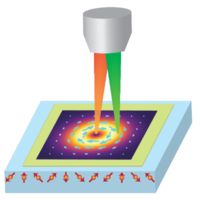当前位置:
X-MOL 学术
›
Phys. Rev. X
›
论文详情
Our official English website, www.x-mol.net, welcomes your
feedback! (Note: you will need to create a separate account there.)
Spatiotemporal Mapping of a Photocurrent Vortex in MonolayerMoS2Using Diamond Quantum Sensors
Physical Review X ( IF 11.6 ) Pub Date : 2020-01-06 , DOI: 10.1103/physrevx.10.011003 Brian B. Zhou , Paul C. Jerger , Kan-Heng Lee , Masaya Fukami , Fauzia Mujid , Jiwoong Park , David D. Awschalom
Physical Review X ( IF 11.6 ) Pub Date : 2020-01-06 , DOI: 10.1103/physrevx.10.011003 Brian B. Zhou , Paul C. Jerger , Kan-Heng Lee , Masaya Fukami , Fauzia Mujid , Jiwoong Park , David D. Awschalom

|
Photocurrents are central to understanding and harnessing the interaction of light with matter. Here, we introduce a contact-free method to spatially resolve photocurrent distributions using proximal quantum magnetometers. We interface monolayer with a near-surface ensemble of nitrogen-vacancy centers in diamond and map the generated photothermal current distribution through its magnetic-field profile. By synchronizing pulsed photoexcitation with dynamical decoupling of the sensor spin, we extend the sensor’s quantum coherence and resolve time-dependent, two-dimensional current densities as small as , with a projected sensitivity of . Our spatially resolved measurements reveal that optical excitation can generate micron-sized photocurrent vortices in , manifesting a photo-Nernst effect exceeding that of gate-tuned graphene at comparable magnetic fields. We further probe the rise time of the photocurrents and show that thermal diffusion determines its spatial variation. These spatiotemporal capabilities establish an optically accessed, local probe for optoelectronic phenomena, ideally suited to the emerging class of two-dimensional materials, for which making contacts is challenging and can alter the intrinsic material properties.
中文翻译:

使用金刚石量子传感器的单层MoS2中光电流涡旋的时空映射
光电流对于理解和利用光与物质的相互作用至关重要。在这里,我们介绍了一种无接触方法,可以使用近端量子磁力计在空间上解析光电流分布。我们连接单层与金刚石中氮空位中心的近地表集合合,并通过其磁场分布图绘制生成的光热电流分布。通过使脉冲光激发与传感器自旋的动态去耦同步,我们扩展了传感器的量子相干性,并解决了与时间有关的二维电流密度小至,预计灵敏度为 。我们在空间上解析的测量结果表明,光激发可以在空气中产生微米级的光电流旋涡。,在可比较的磁场下,表现出的光能斯特效应超过了栅极调谐的石墨烯。我们进一步探究了光电流的上升时间,并表明热扩散决定了其空间变化。这些时空功能为光电现象建立了一个可光学访问的局部探针,非常适合新兴的二维材料,对于这些材料而言,进行接触具有挑战性,并且可以改变材料的固有特性。
更新日期:2020-01-06
中文翻译:

使用金刚石量子传感器的单层MoS2中光电流涡旋的时空映射
光电流对于理解和利用光与物质的相互作用至关重要。在这里,我们介绍了一种无接触方法,可以使用近端量子磁力计在空间上解析光电流分布。我们连接单层与金刚石中氮空位中心的近地表集合合,并通过其磁场分布图绘制生成的光热电流分布。通过使脉冲光激发与传感器自旋的动态去耦同步,我们扩展了传感器的量子相干性,并解决了与时间有关的二维电流密度小至,预计灵敏度为 。我们在空间上解析的测量结果表明,光激发可以在空气中产生微米级的光电流旋涡。,在可比较的磁场下,表现出的光能斯特效应超过了栅极调谐的石墨烯。我们进一步探究了光电流的上升时间,并表明热扩散决定了其空间变化。这些时空功能为光电现象建立了一个可光学访问的局部探针,非常适合新兴的二维材料,对于这些材料而言,进行接触具有挑战性,并且可以改变材料的固有特性。











































 京公网安备 11010802027423号
京公网安备 11010802027423号